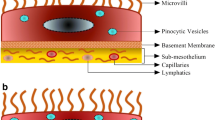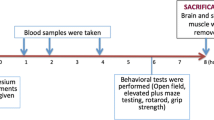Abstract
The aim of this study was to investigate the pharmacokinetics of (−)-epicatechin (EC) in rabbits after intravenous, intraperitoneal, and oral administration. A two-compartment model was used to describe the pharmacokinetics of EC after intravenous administration. EC showed dose-independent pharmacokinetics after intravenous administration. In addition, the area under the concentration-time curve was proportional to the dose over the range 5–25 mg/kg. After intraperitoneal administration of 25 mg/kg, a high percentage of EC escaped from first-pass hepatic elimination. After oral administration of 50 mg/kg, there was a great variation in the pharmacokinetics, and the mean oral bioavailability of EC was 4%. There was no significant difference in the elimination rate constants in all treatments (p>0.05). In conclusion, after intravenous, intraperitoneal, and oral administration of EC, the EC exhibits dose-independent pharmacokinetics in rabbits. The first-pass effect did not participate in the low oral bioavailability. Base on the results of the present study, the other factors may contribute the low oral bioavailability.
Similar content being viewed by others
References
Balentine, D. A., Wiseman, S. A., and Bouwens, L. C. The chemistry of tea flavonoids. Crit. Rev. Food Sci. Nutr., 37, 693–704 (1997).
Cai, Y., Anavy, N. D., and Chow, H. H. Contribution of presystemic hepatic extraction to the low oral bioavailability of green tea catechins in rats. Drug Metab. Dispos., 30, 1246–1249 (2002).
Catterall, F., King, L. J., Clifford, M. N., and Ioannides, C. Bioavailability of dietary doses of 3H-labelled tea antioxidants (+)-catechin and (−)-epicatechin in rat. Xenobiotica, 33, 743–753 (2003).
Chan, K. Y., Zhang, L., and Zuo, Z. Intestinal efflux transport kinetics of green tea catechins in Caco-2 monolayer model. J. Pharm. Pharmacol., 59, 395–400 (2007).
Chang, Q., Zuo, Z., Ho, W. K., and Chow, M. S. Comparison of the pharmacokinetics of hawthorn phenolics in extract versus individual pure compound. J. Clin. Pharmacol., 45, 106–112 (2005).
Chen, L., Lee, M. J., Li, H., and Yang, C. S. Absorption, distribution, elimination of tea polyphenols in rats. Drug Metab. Dispos., 25, 1045–1050 (1997).
Da Silva, E. L., Piskula, M., and Terao, J. Enhancement of antioxidative ability of rat plasma by oral administration of (−)-epicatechin. Free Radic. Biol. Med., 24, 1209–1216 (1998).
Donovan, J. L., Crespy, V., Manach, C., Morand, C., Besson, C., Scalbert, A., and Rémésy, C. Catechin is metabolized by both the small intestine and liver of rats. J. Nutr., 131, 1753–1757 (2001).
Engler, M. B., Engler, M. M., Chen, C. Y., Malloy, M. J., Browne, A., Chiu, E. Y., Kwak, H. K., Milbury, P., Paul, S. M., Blumberg, J., and Mietus-Snyder, M. L. Flavonoid-rich dark chocolate improves endothelial function and increases plasma epicatechin concentrations in healthy adults. J. Am. Coll. Nutr., 23, 197–204 (2004).
Heo, H. J. and Lee, C. Y. Epicatechin and catechin in cocoa inhibit amyloid beta protein induced apoptosis. J. Agric. Food Chem., 53, 1445–1448 (2005).
Heptinstall, S., May, J., Fox, S., Kwik-Uribe, C., and Zhao, L. Cocoa flavanols and platelet and leukocyte function: recent in vitro and ex vivo studies in healthy adults. J. Cardiovasc. Pharmacol., 47Suppl 2, S197–S205 (2006).
Hertog, M. G., Kromhout, D., Aravanis, C., Blackburn, H., Buzina, R., Fidanza, F., Giampaoli, S., Jansen, A., Menotti, A., Nedeljkovic, S., Pekkarine, M., Simic, B. S., Toshima, H., Feskens, E. J., Hollman, P. C., and Katan, M. B. Flavonoid intake and long-term risk of coronary heart disease and cancer in the seven countries study. Arch. Intern. Med., 155, 381–386 (1995).
Higdon, J. V. and Frei, B. Tea catechins and polyphenols: health effects, metabolism, and antioxidant functions. Crit. Rev. Food Sci. Nutr., 43, 89–143 (2003).
Ho, Y., Lee, Y. L., and Hsu, K. Y. Determination of (+)-catechin in plasma by high-performance liquid chromatography using fluorescence detection. J. Chromatogr. B. Biomed. Appl., 665, 383–389 (1995).
Kohri, T., Suzuki, M., and Nanjo, F. Identification of metabolites of (−)-epicatechin gallate and their metabolic fate in the rat. J. Agric. Food Chem., 51, 5561–5566 (2003).
Kuhnle, G., Spencer, J. P., Schroeter, H., Shenoy, B., Debnam, E. S., Srai, S. K., Rice-Evans, C., and Hahn, U. Epicatechin and catechin are O-methylated and glucuronidated in the small intestine. Biochem. Biophys. Res. Commun., 277, 507–512 (2000).
Lee, C. Y. Pharmacokinetics study of (+)-Catechin in rabbits., Master thesis of Taipei Medical University. (1994).
Mandel, S. and Youdim, M. B. Catechin polyphenols: neurodegeneration and neuroprotection in neurodegenerative diseases. Free Radic. Biol. Med., 37, 304–317 (2004).
Meselhy, M. R., Nakamura, N., and Hattori, M. Biotransformation of (−)-epicatechin 3-O-gallate by human intestinal bacteria. Chem. Pharm. Bull. (Tokyo), 45, 888–893 (1997).
Osakabe, N., Baba, S., Yasuda, A., Iwamoto, T., Kamiyama, M., Tokunaga, T., and Kondo, K., Dose-response study of daily cocoa intake on the oxidative susceptibility of lowdensity lipoprotein in healthy human volunteers. J. Health Sci., 50, 679–684 (2004).
Prior, R. L. and Cao, G. Antioxidant capacity and polyphenolic components of teas: implications for altering in vivo antioxidant status. Proc. Soc. Exp. Biol. Med., 220, 255–261 (1999).
Steffen, Y., Schewe, T., and Sies, H. Epicatechin protects endothelial cells against oxidized LDL and maintains NO synthase. Biochem. Biophys. Res. Commun., 331, 1277–1283 (2005).
Takizawa, Y., Morota, T., Takeda, S., and Aburada, M. Pharmacokinetics of (−)-epicatechin-3-O-gallate, an active component of Onpi-to, in rats. Biol. Pharm. Bull., 26, 608–612 (2003).
Vaidyanathan, J. B. and Walle, T. Transport and metabolism of the tea flavonoid (−)-epicatechin by the human intestinal cell line Caco-2. Pharm. Res., 18, 1420–1425 (2001).
Wan, Y., Vinson, J. A., Etherton, T. D., Proch, J., Lazarus, S. A., and Kris-Etherton, P. M. Effects of cocoa powder and dark chocolate on LDL oxidative susceptibility and prostaglandin concentrations in humans. Am. J. Clin. Nutr., 74, 596–602 (2001).
Wang, E. J., Barecki-Roach, M., and Johnson, W. W. Elevation of P-glycoprotein function by a catechin in green tea. Biochem. Biophys. Res. Commun., 297, 412–418 (2002).
Xu, J. Z., Yeung, S. Y., Chang, Q., Huang, Y., and Chen, Z. Y. Comparison of antioxidant activity and bioavailability of tea epicatechins with their epimers. Br. J. Nutr., 91, 873–881 (2004).
Yoshino, K., Suzuki, M., Sasaki, K., Miyase, T., and Sano, M. Formation of antioxidants from (−)-epigallocatechin gallate in mild alkaline fluids, such as authentic intestinal juice and mouse plasma. J. Nutr. Biochem., 10, 223–229 (1999).
Zhang, L., Zheng, Y., Chow, M. S., and Zuo, Z. Investigation of intestinal absorption and disposition of green tea catechins by Caco-2 monolayer model. Int. J. Pharm., 287, 1–12 (2004).
Zhu, M., Chen, Y., and Li, R. C. Oral absorption and bioavailability of tea catechins. Planta Med., 66, 444–447 (2000).
Zhu, M., Chen, Y., and Li, R. C. Pharmacokinetics and system linearity of tea catechins in rat. Xenobiotica., 31, 51–60 (2001). http://www.hsus.org.
Author information
Authors and Affiliations
Corresponding author
Rights and permissions
About this article
Cite this article
Chen, YA., Hsu, KY. Pharmacokinetics of (−)-epicatechin in rabbits. Arch. Pharm. Res. 32, 149–154 (2009). https://doi.org/10.1007/s12272-009-1129-x
Received:
Revised:
Accepted:
Published:
Issue Date:
DOI: https://doi.org/10.1007/s12272-009-1129-x




